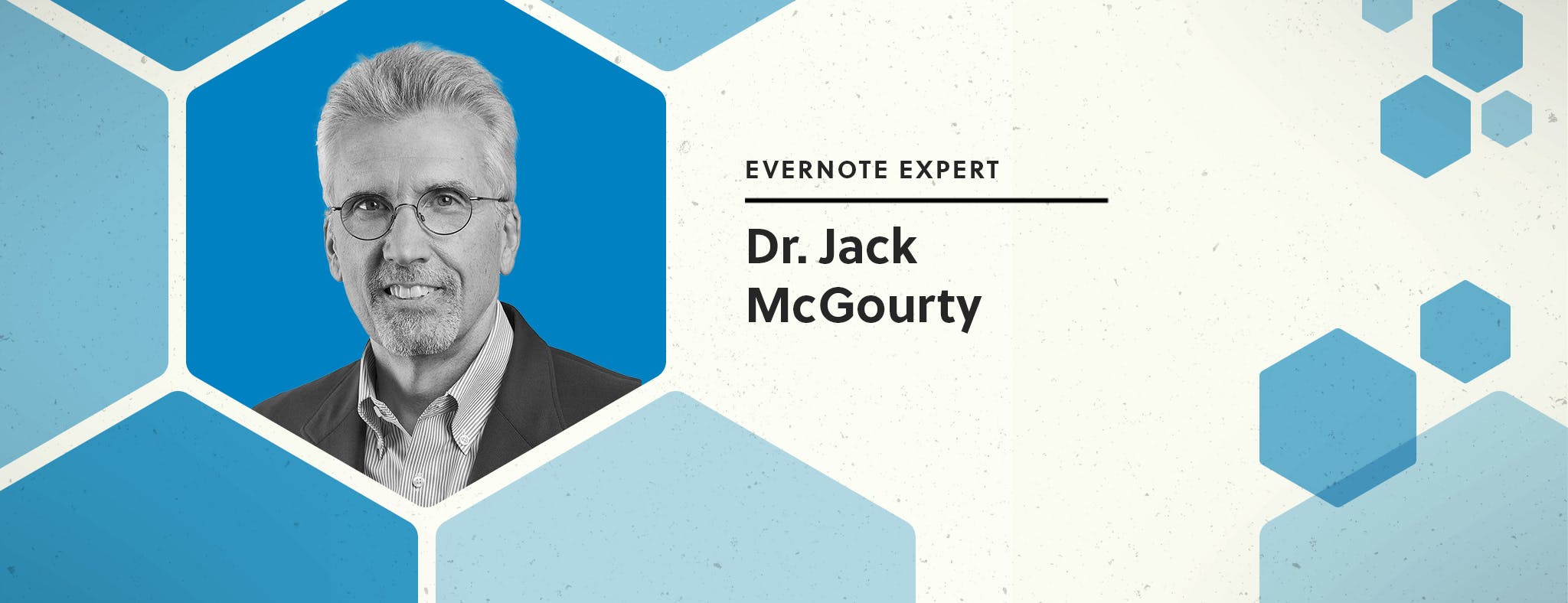As an Evernote Certified Expert and Columbia University Professor, Dr. Jack McGourty is passionate about helping students create and organize their big ideas into new business ventures. Dr. McGourty’s method of approaching a new venture is centered on the process of creating a personal knowledge management system. He has coined an acronym, S.C.O.R.E., to teach students how to think critically about how they will organize their notes, research, and ideas. Can you guess his productivity tool of choice? A+ if you said Evernote!
Whether you’re just starting college for the first time, or you are a super senior taking a victory lap for credits, it’s never too late to learn how to take excellent notes. And what better way to learn than with some advice directly from a college professor?
S – Search
The foundation of a good note-taker starts by thinking about how you search. How do sort through things to you find what you’re looking for? Knowing how you access your information helps you organize it better from the beginning. Dr. McGourty even has his students keep a Search Journal.
“Take notes on a topic you were working on and walk yourself through how you did the search, what worked, and what didn’t work. From there, see if you can find an optimized set of steps to successfully search that work for you.”
Power tip: Evernote makes it easy to quickly locate whatever you’re looking for. Search handwriting, PDFs, and documents, then narrow down your results by filtering for tags, attachments, PDFs, URLs, and more. You’ll get the right results as you type, even if you make a typo.
C – Capture
Where do you think of your most creative ideas? Maybe it’s on a walk, in the shower, or even in the middle of the night. To become an excellent note-taker, you first need a plan for how you’ll capture your big ideas. Dr. McGourty emphasizes the importance of finding ways to capture the idea as close to the moment as possible. But there isn’t a one-size fits all way to capture ideas. It’s important to find what works for you, whether that is handwritten notes, audio, images, etc.
“Find the right way to capture ideas for yourself, and then always do it. Start to practice capturing ideas, and it will become a habit. So it won’t be ‘I have a good idea…’ Now it’s ‘I have a good idea, and I know how to capture it.’”
Power tip: Capture and remember every important idea, project, and piece of information—in any format, from any device, anywhere, at any time. Evernote works across all your devices. Your info is always at your fingertips, so you can stay productive everywhere—even when you’re offline.
O – Organize
Now that you have a plan to capture all your ideas, you’ll need to decide how to organize them. This is where understanding your search strategy plays a critical role. Knowing how you think about concepts and look for things will help you recall your ideas in a timely and efficient way.
A simple way to start organizing is by developing a naming convention for your notes. For example, every class note could start with the class code + class topic + session number. From there, it’s easy to search for all the notes from that class. Dr. McGourty is also a big advocate of using templates to maintain an easily searchable structure for note-taking.
“You want to organize the way your brain works and how the context fits for you. There’s no one right way. When you think about organizing, think about what’s current and what’s actionable.”
Power tip: Use Evernote to record and store an audio recording directly into your notes. In a note, click the Insert button (blue ‘plus’ sign), then click Audio Recording. The recording will start right away. You can type and record at the same time, but if you leave the note, the recording will stop and save. When you’re done, click the Stop button to stop recording and save the audio to your note.
R – Recognize
To Dr. McGourty, recognition is the most important component of becoming an excellent note-taker. Recognizing patterns and seeing how notes associate with each other can really support your ability to recall previously learned information. For example, a concept you read about last semester may be relevant for a different class you’re taking this semester. Being able to link those notes together will allow you to be more efficient with studying, researching, and more.
“Say you learn something in your first year, then all of a sudden in your third year, there is relevancy. You want to be able to watch for the linkages and associations and look for pattern recognition. Linking those notes together is critical.”
Power tip: Internal note links allow you to link from one note to another, making it easy to quickly jump between notes within Evernote. To create a link to a note, open the note, click the More actions button (three dots) at the top of the note, then click Copy internal link.
E – Expand
This last step is all about bringing this information together. You might not need it right away, but as you capture and organize your ideas over time, you are building your very own knowledge management system—or second brain. This way, you don’t lose anything, big or small.
You never know when you might want to access this information, but when you do need it, you will not only have it, but you’ll know exactly how to find it through your searching and organizing methods. Recognizing that some students prefer to handwrite their notes, Dr. McGourty emphasizes the importance of scanning those notes to help you access and search more effectively.
“There is nothing wrong with handwriting. It can even help concretize information in your memory. You should then take a scan of that note and put it in Evernote so you can search for it later. Years from now, you don’t have to worry about where that note is. You have it in Evernote.”
Power tip: Use Evernote on your phone as a pocket scanner. Capture photos of whiteboards, handwritten notes, and documents to Evernote. Once you’ve captured an image, Evernote automatically crops and enhances the image by adjusting the brightness, contrast, and clarity. Any documents you’ve scanned and saved into Evernote can easily be searched, annotated, and shared.
Using this tried and true note-taking method can really help students think through their knowledge management strategy to become better students and even better professionals in the future.
To learn more from Dr. Jack McGourty, visit his website: Venture For All.

